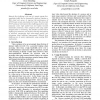Free Online Productivity Tools
i2Speak
i2Symbol
i2OCR
iTex2Img
iWeb2Print
iWeb2Shot
i2Type
iPdf2Split
iPdf2Merge
i2Bopomofo
i2Arabic
i2Style
i2Image
i2PDF
iLatex2Rtf
Sci2ools
ICNS
2007
IEEE
2007
IEEE
Improving Wireless Access of Video Over the Internet
Network flow buffering is the use of a simple remote flowregulating buffer that is dynamically deployed between a Web client and server to improve the performance of HTTP-based access and playback of video. We show that HTTP enhanced with network flow buffering performs well, especially under high packet loss and highly variable bandwidth conditions, when compared with using either straight HTTP or streaming. The benefits of network flow buffering are numerous, and include reducing interruptions to playback, maintaining high video-image quality, and decreasing client buffering requirements. Network flow buffering can be easily implemented using existing Web mechanisms.
Client Buffering Requirements | Computer Networks | Flow Buffering Performs | ICNS 2007 | Network Flow Buffering |
| Added | 03 Jun 2010 |
| Updated | 03 Jun 2010 |
| Type | Conference |
| Year | 2007 |
| Where | ICNS |
| Authors | Jesse Steinberg, Joseph Pasquale |
Comments (0)

